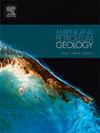High-resolution oceanic anoxic event 2 (OAE2) records from the north of eastern Tethys and evidence for short-term sea regression and wildfire at its early phase
IF 3.7
2区 地球科学
Q1 GEOSCIENCES, MULTIDISCIPLINARY
引用次数: 0
Abstract
Oceanic Anoxic Event 2 (OAE2), occurring at the Cenomanian-Turonian boundary (CTB; 93.9 Ma), is a representative global event of carbon cycling fluctuations and transient climate anomalies. OAE2 was initially discovered and intensively studied in the trans-Atlantic and western Tethys Oceans; however, research on the eastern Tethys Ocean, especially the vast northern regions, is inadequate. Further, there is still considerable controversy regarding the triggering mechanisms and early environmental changes of OAE2. In this study, we present high-resolution carbonate carbon isotopes (δ13Ccarb), total organic carbon, and mercury (Hg) concentration records from the northern part of the eastern Tethys Ocean during the OAE2 interval, sampled at the ZK20-1 drillcore section of the Kukebai Formation in the western Tarim Basin, China. Following the global classification scheme for carbon isotope excursion (CIE) at the CTB, the carbon isotope change curve of this study is classified into six stages (C1-C6), and three substages (C3a, C3b, C3c) in the C3 stage. Sedimentary features reveal a short-term sea-level regression in the Tarim Basin during the onset stage (C2) of OAE2, which likely involved vast regions of the eastern Tethys Ocean and even the Pacific region. The mercury (Hg) concentration data reveal increasing Hg levels in the lower part of the Kukebai Formation, mainly corresponding to the onset stage (C3) of the OAE2, but it is significantly lower than that in other typical volcanogenic Hg anomalies. We preliminarily speculated that the intensified wildfire activity at the onset stage of OAE2 potentially accelerate the Hg extracted from the terrestrial soil or organic matter into the offshore area. This is also supported by the evidence of wildfire and Hg anomalies from the Western Interior Seaway (WIS) of North America.
东特提斯北部的高分辨率大洋缺氧事件 2(OAE2)记录及其早期阶段的短期海退和野火证据
大洋缺氧事件 2(Oceanic Anoxic Event 2,OAE2)发生在震旦纪-震旦纪边界(Cenomanian-Turonian boundary,CTB;93.9 Ma),是碳循环波动和瞬时气候异常的代表性全球事件。OAE2 最初是在跨大西洋和特提斯洋西部被发现和深入研究的;然而,对特提斯洋东部,特别是北部广大地区的研究还很不够。此外,关于 OAE2 的触发机制和早期环境变化仍存在很大争议。在本研究中,我们在中国塔里木盆地西部库克拜地层 ZK20-1 钻芯剖面取样,展示了 OAE2 期间东特提斯洋北部的高分辨率碳酸盐碳同位素(δ13Ccarb)、总有机碳和汞浓度记录。按照CTB碳同位素偏移(CIE)的全球划分方案,本研究将碳同位素变化曲线划分为六个阶段(C1-C6),以及C3阶段的三个子阶段(C3a、C3b、C3c)。沉积特征显示,在 OAE2 开始阶段(C2),塔里木盆地出现了短期海平面倒退,可能涉及特提斯洋东部甚至太平洋地区的广大区域。汞(Hg)浓度数据显示,库克拜地层下部的汞含量不断增加,主要与 OAE2 开始阶段(C3)相对应,但明显低于其他典型的火山成因汞异常。我们初步推测,在 OAE2 开始阶段,野火活动的加剧可能会加速从陆地土壤或有机物中提取的汞进入近海区域。北美西部内陆海道(WIS)的野火和汞异常证据也支持这一观点。
本文章由计算机程序翻译,如有差异,请以英文原文为准。
求助全文
约1分钟内获得全文
求助全文
来源期刊

Marine and Petroleum Geology
地学-地球科学综合
CiteScore
8.80
自引率
14.30%
发文量
475
审稿时长
63 days
期刊介绍:
Marine and Petroleum Geology is the pre-eminent international forum for the exchange of multidisciplinary concepts, interpretations and techniques for all concerned with marine and petroleum geology in industry, government and academia. Rapid bimonthly publication allows early communications of papers or short communications to the geoscience community.
Marine and Petroleum Geology is essential reading for geologists, geophysicists and explorationists in industry, government and academia working in the following areas: marine geology; basin analysis and evaluation; organic geochemistry; reserve/resource estimation; seismic stratigraphy; thermal models of basic evolution; sedimentary geology; continental margins; geophysical interpretation; structural geology/tectonics; formation evaluation techniques; well logging.
 求助内容:
求助内容: 应助结果提醒方式:
应助结果提醒方式:


